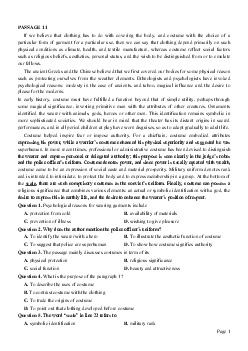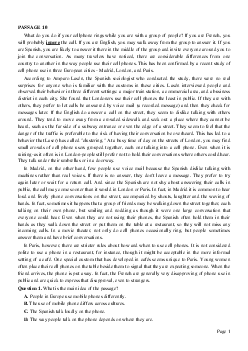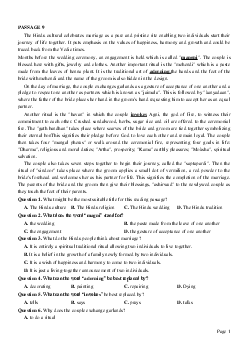


Preview text:
PASSAGE 4
Read the following passage and mark the letter A, B, C, or D on your answer sheet to indicate the
correct answer to each of the questions
Butterflies are among the most extensively studied insects - an estimated 90 percent of the world's
species have scientific names. As a consequence, they are perhaps the best group of insects for examining
patterns of terrestrial biotic diversity and distribution. Butterflies also have a favorable image with the
general public. Hence, they are an excellent group for communicating information on science and
conservation issues such as diversity.
Perhaps the aspect of butterfly diversity that has received the most attention over the past century is
the striking difference in species richness between tropical and temperate regions.
For example, in 1875 one biologist pointed out the diversity of butterflies in the Amazon when he
mentioned that about 700 species were found within an hour's walk, whereas the total number found on
the British islands did not exceed 66, and the whole of Europe supported only 321. This early comparison
of tropical and temperate butterfly richness has been well confirmed.
A general theory of diversity would have to predict not only this difference between temperate and
tropical zones, but also patterns within each region, and how these patterns vary among different animal
and plant groups. However, for butterflies, variation of species richness within temperate or tropical
regions, rather man between them, is poorly understood. Indeed, comparisons of numbers of species
among the Amazon basin, tropical Asia, and Africa are still mostly "personal communication" citations,
even for vertebrates, In other words, unlike comparison between temperate and tropical areas, these
patterns are still in the documentation phase.
In documenting geographical variation in butterfly diversity, some arbitrary, practical decisions are
made. Diversity, number of species, and species richness are used synonymously; little is known about
the evenness of butterfly distribution. The New World butterflies make up the preponderance of examples
because they are the most familiar species. It is hoped that by focusing on them, the errors generated by
imperfect and incomplete taxonomy will be minimized.
Question 1. The word "consequence" in line 2 is closest in meaning to . A. result B. explanation C. analysis D. requirement
Question 2. The word "striking" in line 7 is closest in meaning to . A. physical B. confusing C. noticeable D. successful
Question 3. Butterflies are a good example for communicating information about conservation issues because they .
A. are simple in structure
B. are viewed positively by people
C. have been given scientific names
D. are found mainly in temperate climates
Question 4. The word “exceed” in line 10 is closest in meaning to . A. locate B. allow C. go beyond D. come close to
Question 5. Which of the following is NOT well understood by biologists?
A. European butterfly habitats
B. Differences in species richness between temperate and tropical regions
C. Differences in species richness within a temperate or a tropical region
D. Comparisons of behavior patterns of butterflies and certain animal groups Page 1
Question 6. All of the followings are mentioned as being important parts of a general theory of diversity EXCEPT .
A. differences between temperate and tropical zones
B. patterns of distribution of species in each region
C. migration among temperate and tropical zones
D. variation of patterns of distribution of species among different animals and plants
Question 7. Which aspect of butterflies does the passage mainly discuss?
A. Their physical characteristics
B. Their adaptation to different habitats C. Their names D. Their variety
Question 8. The author mentions tropical Asia in lines 16 - 17 as an example of a location where .
A. butterfly behavior varies with climate
B. a general theory of butterfly diversity has not yet been firmly established
C. butterflies are affected by human populations
D. documenting plant species is more difficult than documenting butterfly species
Question 9. The word "generated" in line 24 is closest in meaning to . A. requested B. caused C. assisted D. estimated Page 2 ĐÁP ÁN 1-A 2-C 3-C 4-C 5-B 6-C 7-D 8-B 9-B
LỜI GIẢI CHI TIẾT Question 1: A Question 2: C
C: striking = noticeable (a) nổi bật Question 3: C
B: thông tin trong bài “Butterflies also have a favorable image with the general public.” Favorable image
– hình ảnh được ưa thích = positively viewed – được nhìn nhận 1 cách tích cực Question 4: C
C: exceed = go beyond (v) vượt quá, quá mức Question 5: B
C: Thông tin trong câu: However, for butterflies, variation of species richness within temperate or tropical
regions, rather than between them, is poorly understood Question 6: C
C: Thông tin trong câu: A general theory of diversity would have to predict not only this difference
between temperate and tropical zones, but also patterns within each region, and how these patterns vary
among different animal and plant groups. Question 7: D D: thông tinđược giới thiệu ở đầu:
Butterflies are among the most extensively studied insects—an estimated 90 percent of the world's
species have scientific names. As a consequence, they are perhaps the best group of insects for examining
patterns of terrestrial biotic diversity and distribution Question 8: B Question 9: B
B: generated = caused – được tạo ra, được gây ra, được sản sinh ra Page 3




